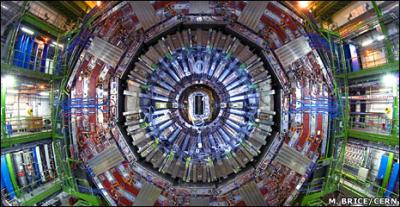Topic: SCIENCE - on September 11, 2008 at 12:16:00 PM CEST
Large Hadron Collider "Actually Worked"
The world's largest atom smasher's first experiment went off today without a hitch, paving the way toward the recreation of post-big bang conditions.
... Link (0 comments) ... Comment
Topic: SCIENCE - on September 9, 2008 at 3:31:00 PM CEST
Large Hadron Collider - LHC - CERN - 8:30 on 10 September - First Beam
dont fiddle around with the systems

mms://a23.l4162634022.c41626.e.lm.akamaistream.net/D/23/41626/v0001/reflector:34022 !!! - Live webcast (from 8:30 on 10 September) Planning of the day Live satellite broadcast information Watch the LHC startup in EVO.
... Link (0 comments) ... Comment
Topic: SCIENCE - on September 9, 2008 at 11:32:00 AM CEST
LHC Webcast - Large Hadron Collider
Wenn am Mittwoch um 9 Uhr morgens der erste Teilchenstrahl durch den Large Hadron Collider unter’m CERN gebeamt wird, kann man live in deren Webcast verfolgen, wie ein schwarzes Loch erst ein paar Wissenschaftler, dann eine Riesenmaschine und schließlich den ganzen Planeten verschluckt. Und ja, ich weiß, dass das nicht passieren wird, LHC-Content liest sich aber besser mit einer ordentlichen Portion Apokalypse.

... Link (0 comments) ... Comment
Topic: SCIENCE - on August 22, 2008 at 10:42:00 AM CEST
Solar Cells — Made In a Pizza Oven
The winner of several Eureka Science Awards in Australia is a crafty chick who devised a way to create solar cells cheaply using a pizza oven, nail polish and an inkjet printer. This was developed to address the high cost of cells and in particular for the world's poorest regions. She wanted to give the ~2 billion people around the world who don't have electricity the gift of light and cheap energy. This could have profound (and a good profound) implications for education and health in those in the poorest regions in the world. And it all started with her parents giving her a solar energy kit when she was 10...
... Link (0 comments) ... Comment
Topic: SCIENCE - on August 18, 2008 at 10:49:00 AM CEST
Mimicking Photosynthesis To Split Water
An international team of researchers led by Monash University has used chemicals found in plants to replicate a key process in photosynthesis, paving the way to a new approach that uses sunlight to split water into hydrogen and oxygen. The breakthrough could revolutionize the renewable energy industry by making hydrogen — touted as the clean, green fuel of the future — cheaper and easier to produce on a commercial scale.
... Link (0 comments) ... Comment
Topic: SCIENCE - on August 17, 2008 at 2:51:00 PM CEST
Stone Age mass graves reveal green Sahara
One of the driest deserts in the world, the Saharan Tenere Desert, hosted at least two flourishing lakeside populations during the Stone Age, a discovery of the largest graveyard from the era reveals.
The archaeological site in Niger, called Gobero, was discovered by Paul Sereno at the University of Chicago, during a dinosaur-hunting expedition. It had been used as a burial site by two very different populations during the millennia when the Sahara was lush.
Careful examination of 67 graves - a third of the 200 plots on the site - has uncovered unprecedented details about the lifestyles of the people who inhabited the green Stone Age "desert", says Sereno.
... Link (0 comments) ... Comment
Topic: SCIENCE - on August 16, 2008 at 3:05:00 PM CEST
Self -growing material promises chip, storage advances
In the ever-growing desire to product smaller, less costly yet more powerful and faster computers and storage devices, researchers today said they are looking at a way to use self-growing fabrics that will let manufacturers build nano-sized high resolution semiconductors and arrays that answer that craving.
Researchers at the Nanoscale Science and Engineering Center (NSEC) at the University of Wisconsin - Madison have come up with a method that uses existing technology to combine the lithography techniques traditionally used to pattern microelectronics with novel self-assembling materials known as block copolymers, researchers said. When combined with a lithographically patterned surface, the block copolymers' long molecular chains spontaneously assemble into the designated arrangements, researchers said.
... Link (0 comments) ... Comment
Topic: SCIENCE - on August 3, 2008 at 8:21:00 PM CEST
The Brightest, Sharpest, Fastest X-Ray Holograms Yet
The pinhole camera, a technique known since ancient times, has inspired a futuristic technology for lensless, three-dimensional imaging. Working at both the Advanced Light Source (ALS) at the U.S. Department of Energy’s Lawrence Berkeley National Laboratory, and at FLASH, the free-electron laser in Hamburg, Germany, an international group of scientists has produced two of the brightest, sharpest x-ray holograms of microscopic objects ever made, thousands of times more efficiently than previous x-ray-holographic methods.
... Link (0 comments) ... Comment
Topic: SCIENCE - on August 2, 2008 at 12:49:56 PM CEST
MIT claims 24/7 solar power
Researchers at the Massachusetts Institute of Technology have combined a liquid catalyst with photovoltaic cells to achieve what they claim is a solar energy system that could generate electricity around the clock.
A liquid catalyst was added to water before electrolysis to achieve what the researchers claim is almost 100-percent efficiency. When combined with photovoltaic cells to store energy chemically, the resulting solar energy systems could generate electricity around the clock, the MIT team said.
... Link (0 comments) ... Comment
Topic: SCIENCE - on July 28, 2008 at 12:22:57 PM CEST
Silent spring
Deep in the radioactive bowels of the smashed Chernobyl reactor, a strange new lifeform is blooming.
TWENTY-TWO YEARS AGO, on 26 April 1986, reactor No 4 at the Chernobyl Nuclear Power Plant, in Ukraine, blew apart, spewing radioactive dust and debris far and wide.
Ever since, a 30 km 'exclusion zone' has existed around the contaminated site, accessible to those with special clearance only. It's quite easy, then, to conjure an apocalyptic vision of the area; to imagine an eerily deserted wasteland, utterly devoid of life.
... Link (0 comments) ... Comment
Topic: SCIENCE - on July 20, 2008 at 2:04:00 PM CEST
Cern lab goes 'colder than space'
A vast physics experiment built in a tunnel below the French-Swiss border is fast becoming one of the coolest places in the Universe.
The Large Hadron Collider is entering the final stages of being lowered to a temperature of 1.9 Kelvin (-271C; -456F) - colder than deep space.
The LHC has thousands of magnets which will be maintained in this frigid condition using liquid helium.

... Link (0 comments) ... Comment
Topic: SCIENCE - on July 18, 2008 at 12:55:18 PM CEST
Women's brains are different from men's – and here's scientific proof
Men and women show differences in behaviour because their brains are physically distinct organs, new research suggests. Male and female brains appear to be constructed from markedly different genetic blueprints.
The differences in the circuitry that wires them up and the chemicals that transmit messages inside them are so great as to point to the conclusion that there is not just one kind of human brain, but two, according to recent neurological studies.
... Link (0 comments) ... Comment










